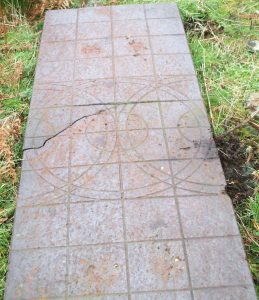High in the hills above Ellenabeich, hidden from view, there is a long, sheltered valley. This was once a military rifle range. At its far end rusting targets defy a century and a quarter of Atlantic storms. Two iron frames crouch behind earth banks faced with stone. In front of the earth banks there are heavy slabs of cast iron sheltering beneath a blanket of bracken. They are peppered with the scars of bullets fired long ago. The Easdale Volunteers used this range. They trained with Snider-Enfield carbines, powerful rifles which could fire half-inch calibre bullets over six hundred yards.
Construction began in 1887, as soon as Captain Stewart MacDougall had written his report. He had travelled from Paisley, where he was adjutant of the militia battalion and qualified to approve plans for new rifle ranges. His report survives and its recommendations were specific: a length of five hundred yards with two lanes; a stop-butt, to catch stray bullets, forty-five feet long and twenty feet high; and two earth banks as marker butts near the targets. At the firing points: wooden platforms in two places where the ground dropped, and the side of a small hill dug out to form a level area at the five-hundred yard point. You can stand there today, peering at the butts so far away, wondering how accurate the firing could have been from this distance.
In September 1887 the rifle range opened, just five months after Captain MacDougall’s visit. The great slabs of cast iron were the only targets in those days. They would have been hauled upright and made secure with iron poles bolted to their rear. Each target was two centimetres thick, almost two metres tall and half a metre wide. On the front was a deeply-engraved grid of large squares and concentric circles. Men would blacken the bull’s-eye with lamp black, a pigment made from soot, and cover the remainder with white chalk. For the annual tests, soldiers fired ten rounds from a hundred and fifty yards away before moving back fifty yards and firing another ten rounds. Further back, at the three hundred yard point, they climbed upon wooden platforms one metre high and fired their remaining ten bullets. During each pause in the shooting, men in the marker butts would signal the results: a red and white flag for a bull’s-eye, dark blue for a hit within the outer circle, and white for a strike elsewhere.
By the turn of the century the War Office had banned the use of these targets. Rifles were becoming more powerful. Bullets ricocheting from solid cast iron could injure the men in the butts. New targets – Ralston Canvas Targets – were introduced. There were two designs and one of each has survived at the range above Ellenabeich. Target frames held canvas panels with paper or card targets fixed to them. A simple mechanism allowed them to be raised and lowered from view. Being canvas, bullets would pass through them before being caught in the stop-butt beyond.
Five miles across the sea, on the Isle of Luing, a drill station was established in 1897 for the Luing section of the Easdale Volunteers. A rifle range was built there too. It had one lane, a length of eight hundred yards and a Ralston Target. Today its rusting frame also survives.
When Captain Stewart MacDougall returned to Paisley after his visit here in early 1887, he could not have imagined that evidence of his rifle range would survive for a century and a quarter.

Left- a cast iron target, two metres long, pitted with bullet scars. The bull’s-eye would have been blackened with lamp black pigment.
Top photo – a mechanical Ralston target frame with cogwheels to raise and lower canvas targets.
